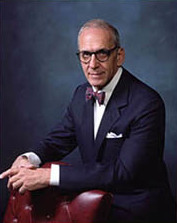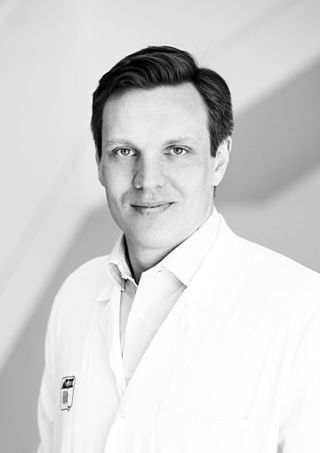
A brain tumor occurs when abnormal cells form within the brain. There are two main types of tumors: malignant (cancerous) tumors and benign (non-cancerous) tumors. These can be further classified as primary tumors, which start within the brain, and secondary tumors, which most commonly have spread from tumors located outside the brain, known as brain metastasis tumors. All types of brain tumors may produce symptoms that vary depending on the size of the tumor and the part of the brain that is involved. Where symptoms exist, they may include headaches, seizures, problems with vision, vomiting and mental changes. Other symptoms may include difficulty walking, speaking, with sensations, or unconsciousness.

In 1916, the Daughters of Charity of Saint Vincent de Paul launched a Catholic hospital called St. Vincent's Medical Center Riverside. They provide full-service tertiary care at a capacity of 528 beds.

Uppsala University Hospital in Uppsala, Sweden, is a teaching hospital for the Uppsala University Faculty of Medicine and the Nursing School. Uppsala University Hospital is owned and operated by the Uppsala County Council in cooperation with the university and serves, together with Enköping hospital in Enköping, as the primary hospitals for Uppsala County. It also fills the function of a tertiary referral hospital for the Uppsala/Örebro health care region and, for certain specialities, a tertiary referral hospital for the entire country of Sweden.
Leonard J. Cerullo is a board-certified neurosurgeon and founder/medical director.

Pleomorphic xanthoastrocytoma (PXA) is a brain tumor that occurs most frequently in children and teenagers. At Boston Children's Hospital, the average age at diagnosis is 12 years.
Dong-A University Hospital (동아대학교의료원) is a major general hospital affiliated with Dong-A University in Busan, South Korea.
Griffith Rutherford Harsh IV is an American neurosurgeon. In 2018, he became the chair of the department of neurological surgery at UC Davis Health.
The Mischer Neuroscience Institute is a combined research and education effort between the Vivian L. Smith Department of Neurosurgery and the Department of Neurology at McGovern Medical School at UTHealth Houston and Memorial Hermann Hospital. Located in Houston, the Institute draws patients from around the world for specialized treatment of diseases of the brain and spine. It was the first center in Texas and one of only a few institutions in the country to fully integrate neurology, neurosurgery, neuroradiology, neuro-oncology, spine surgery, pain medicine and neurorehabilitation.
The Alvin J. Siteman Cancer Center at Barnes-Jewish Hospital and Washington University School of Medicine is a cancer treatment, research and education institution with six locations in the St. Louis area. Siteman is the only cancer center in Missouri and within 240 miles of St. Louis to be designated a Comprehensive Cancer Center by the National Cancer Institute (NCI). Siteman is also the only area member of the National Comprehensive Cancer Network, a nonprofit alliance of 32 cancer centers dedicated to improving the quality and effectiveness of cancer care.
Professor Minesh P. Mehta, MD, FASTRO, is an American radiation oncologist and physician-scientist of Indian origin, Ugandan birth, Zambian Schooling and American Training, who contributed to the field of oncology for more than two and half decades.

Aaron A. Cohen-Gadol is a professor of neurological surgery in the department of neurosurgery at Indiana University School of Medicine and a neurosurgeon at Indiana University Health specializing in the surgical treatment of complex brain tumors, vascular malformations, cavernous malformations, etc. He performs removal of brain tumors via minimally invasive endoscopic techniques, which use the nasal pathways instead of opening the skull.
Arthur L. Jenkins III is an American fellowship-trained neurosurgeon, co-director of the Neurosurgical Spine Program, and Director of Spinal Oncology and Minimally Invasive Spinal Surgery (MIS) Program at the Mount Sinai Hospital, New York. Additionally, he is an associate professor of Neurosurgery and of Orthopedic Surgery at the Mount Sinai School of Medicine. Dr. Jenkins has multiple patents and patent applications for spine-related implants and support systems, and is developing new minimally invasive treatments for patients with cancer that has spread to the spine. He is an innovator in the treatment of acute spinal cord injury as well as degenerative and congenital anomalies of the spine, taking a minimally invasive or minimal-impact approach where possible. He is board certified in Neurological Surgery and is licensed in New York and Connecticut.

James Ivan Ausman is an American neurosurgeon, science editor, television broadcaster, medical entrepreneur, and public advocate on health-care reform. He currently is professor of neurosurgery at the University of California, Los Angeles and editor-in-chief of Surgical Neurology International.

Matthias Preusser is an Austrian oncologist and Professor of Medical Oncology as well as Head of the Clinical Division of Oncology at the Medical University of Vienna. He is known for his work on neurooncology, Molecular Therapy targets and biomarkers and immunotherapy of cancer.
Dr. Matthias Gromeier is a Professor in the Department of Neurosurgery at Duke University Medical Center, who has developed a way to re-engineer a poliovirus to inspire the human immune system to kill cancer cells in a specific set of cancers. The re-engineered virus, called PVSRIPO, cannot replicate itself in normal cells, but can replicate itself in cancer cells that have an overabundance of the protein marker that the poliovirus targets.
John Howard Sampson is an American neurosurgeon who was formerly chief of the department of neurosurgery at Duke University where he serves as a professor of surgery, biomedical engineering, immunology, and pathology.
Robert Wheeler Rand, was an American neurosurgeon, inventor, and Professor of Neurosurgery in the Department of Neurosurgery at the University of California Los Angeles (UCLA) from 1953 to 1989.
Donald M. O'Rourke is an American neurosurgeon and the John Templeton, Jr., MD Professor of Neurosurgery at the Perelman School of Medicine at the University of Pennsylvania. He graduated from Harvard University with an A.B. in Biochemistry and Molecular Biology in 1983, and attended medical school at the University of Pennsylvania where he also completed neurosurgical residency training. He established the institution's human brain tumor tissue bank in 2001. An elected member of the American Academy of Neurological Surgery, his research at the Translational Center of Excellence in the Abramson Cancer Center focuses on Glioblastoma Multiforme, especially the design and investigation of Chimeric Antigen Receptor immune therapies.
Nelson M. Oyesiku is a Nigerian-American professor of neurosurgery and endocrinology. With a specialty in pituitary medicine and surgery, currently, he is the chair of the department of Neurological Surgery and Professor of Medicine (Endocrinology) at the University of North Carolina in Chapel Hill. he has been editor-in-chief of Neurosurgery, Operative Neurosurgery, and Neurosurgery Open. He was previously chair of the American Board of Neurological Surgery, among other organizations.
Linda M. Liau is an American neurosurgeon, neuroscientist, and the W. Eugene Stern Chair of the Department of Neurosurgery at the David Geffen School of Medicine at UCLA. Liau was elected to the Society of Neurological Surgeons in 2013 and the National Academy of Medicine in 2018. She has published over 230 research articles and a textbook, Brain Tumor Immunotherapy. She served as editor-in-chief of the Journal of Neuro-Oncology from 2007 to 2017.





